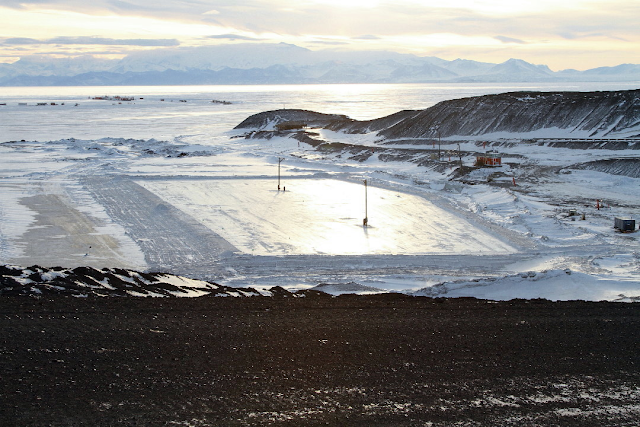Opened in 1956, McMurdo is the most impressive of all Antarctic stations, gathering nearly 1,000 people in the summer period. The station is the logistics hub for the United States in the southern continent, but until 1965 ships “were forced to unload cargo onto the annual ice at some distance from the base”.
During Operation Deep Freeze 1965, “favorable annual ice conditions in the Ross Sea and in the approaches to McMurdo Sound permitted ice breakers to open a channel and clear a turning basin around the shore-fast ice in Winter Quarters Bay. The fast ice (…) served effectively as a wharf (…). For the first time in Deep Freeze history, all cargo ships and tankers were able to off-load directly onto Ross Island, discharging cargo onto trucks and trailers in a conventional, efficient fashion” (https://www.southpolestation.com/trivia/igy2/icewharf1973.pdf, p. 4). This natural ice wharf, named Elliott Quay (https://www.southpolestation.com/trivia/igy2/igy2.html), received a steel-and-timber reinforcement in 1972 –destroyed by storm and tidal action in the same year.
Having a wharf next to the base meant that the United States Antarctic Program would not have to rely on the difficult and dangerous operations carried out over the seasonal fast ice in the nearby areas of McMurdo. However, a reliable man-made structure would have to be able to withstand the waves and small icebergs.
In 1973 the U.S. Navy built a prototype ice pier, using a method that has been perfected over time (so far, at least ten such structures have been made). Basically, it consists of an ice block, large enough to last for three to five summers before it is discarded.
The ice pier in January 2015
The construction process starts in early winter, when sea ice is approximately half a meter thick, strong enough to support the weight of the required equipment. An area of about 100 x 45 m (https://www.epa.gov/ocean-dumping/ocean-disposal-man-made-ice-piers) is selected and its surface is scraped free of snow – the cleared snow will be used “to build berms along the edge of what will become the pier. The berms are frozen to create a dam that will trap water on top of the pier as it is flooded and thickened” (https://antarcticsun.usap.gov/AntarcticSun/features/documents/icepier.pdf). Seawater pumping is done in successive repetitions so that each layer of water solidifies and increases the height of the block:
When the ice pier is between two and three meters thick, a layer of gravel will be spread evenly, in order to protect it from the growing heat and also to provide a non-slip working surface:
If the construction has been done successfully, the pier will already be sturdy enough not to melt for some seasons. By the end of each summer, the National Science Foundation decides whether the ice pier will be maintained for next year (in that case, a winter maintenance operation is performed) or if it is not safe to use it. If it is not appropriate to keep it, the structure is then towed out to sea. The worn-out ice pier shown in the figure below, on the right (beyond the new one), could no longer be used:
Weather in Antarctica is unpredictable, and severe storms can occur. The ice pier can be seriously affected:
In the summer of 2010-11, the ice pier built in 2010 (the same of the photo above and the newest one in the picture before that) ended up breaking loose and drifted away. It was found in October 2011, in the middle of sea ice and miles away from the base (https://antarcticsun.usap.gov/features/2548/):
In other situations, the ice pier has collapsed (the two photos below are from the 1983 summer season):
The high temperatures during the winter of 2011 did not allow the construction of an ice pier sufficiently thick (https://www.southpolestation.com/mcm/1112/shipping2.html). Thus, by early 2012 the U.S. Army 331st Transportation Company assembled a Modular Causeway System (MCS) to replace to ice pier:
Once the annual supply was completed, the MCS was dismantled and, during the winter of 2012, the construction of a new ice pier took place. The operation was successful, but this ice pier only lasted until February 2014 (http://bottom-of-the-earth.blogspot.com/2014/02/vessel.html). A new ice pier was built in 2015 (https://www.msc.navy.mil/sealift/2015/Winter/mcmurdo.htm), but we do not know how long it lasted. For summer 2019-20, the Modular Causeway System was once again necessary, as the unusually warm 2019 winter prevented the construction of the ice pier (https://twitter.com/Antarctic_Infra/status/1223186741454155776).
The video below (available at https://www.youtube.com/watch?v=dUCPFfirE_U&feature=youtu.be&t=11) shows operations on the ice pier in time-lapse. After 1:16, the interesting and intense unloading works of the cargo ship MV Ocean Giant can be seen:
_____________________________________
Photo 1: https://www.jeffreydonenfeld.com/blog/2015/01/ship-operations-at-the-worlds-southernmost-seaport/;
Photos 2 and 3: ?;
Photo 4: bigblueglobe.blogspot.com/2010/11/just-add-dirt.html;
Photos 5 to 9: ?;
Photos 10 to 12: bigblueglobe.blogspot.com/2011/10/ice-piers-been-found.html;
Photos 13 and 14: Randy C. Bunney;
Photos 15 to 20: 331 Transportation Company (Causeway) – https://www.facebook.com/331CauswayCo.

























































